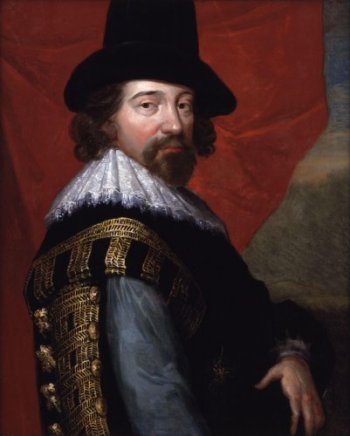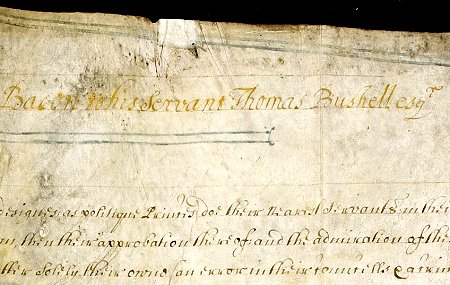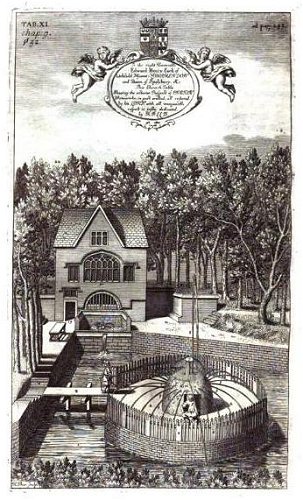Francis Bacon’s seminal science fiction work, The New Atlantis, was first published posthumously in 1627. Most of the analysis of this work has been of the content, purpose, and influences to it’s creation. It has usually been only an aside to the investigation to muse on the actual date Bacon began writing it. Of course this has been of great interest to me, considering I am looking at the possibility that the Voynich is an artifact from this very mythology, and the Voynich most likely predates the publication of the New Atlantis.
So what dating evidence exists for the New Atlantis, prior to publication, and in “my” time frame? James Spedding, from Volume 5, The Works of Francis Bacon, notes, “The New Atlantis seems to have been written in 1624…” This is based on the statement by Bacon’s secretary, Rawley, “…but foreseeing it would be a long work, his desire of collecting the Natural History diverted him…”. And that does imply Bacon was working on the New Atlantis about 1624, but not that he began it… in practice or visualization of the concept… starting then. Even Spedding then adds…
“If the New Atlantis had been written in the earlier part of James’s reign, Bacon might have been suspected [of alluding to Salomona as James I]. He might have hoped to encourage James to justfy the parallel by going and doing likewise. But since James had now reigned [1624] above twenty years without doing or attempting to do anything for the furtherence of Natural Philosophy; without showing any interest in it or any taste or capacity for it; I cannot understand what the allusion can be or where the resemblance.”
In this we see Spedding had a reservation, which might have caused him pause with the 1624 assumption. How often do these yellow flags jump up in our line of sight, and we ignore them, for the sake of anchoring our beliefs in the safe, established, provable? The world of scholarship would disassemble itself if we ran with every unprovable doubt, and yet I applaud a Spedding or anyone, for noting them. As they accumulate over time, from many sources, or are matched with new revelations, these doubts may become part of a new understanding.
Countering the 1624 group, there has been an alternate view about the formation of the concept of The New Atlantis, based mostly on evidence in Bacon’s alluding to various concepts in the work. Catherine Drinker Bowen, in her 1963 Francis Bacon: The Temper of a Man, writes,
“Some time before 1618– we do not know exactly when– Bacon put aside The Great Instauration and sat down to try if he might draw men’s minds to his scheme by way of a simple tale, a fable, and allegory after the manner of that Utopia composed by another, earlier Lord Chancellor, Sir Thomas More. Bacon called his fable the New Atlantis.”
There are others. From the bibliography of Utopia and the Ideal Society, by J.C. Davis, we also have “‘1614-17’, S. R. Gardiner, ‘Francis Bacon’, Dictionary of National Biography; Fulton H. Anderson, Francis Bacon: His Career and His Thought (Los Angeles, Calif., 1962… …’Sometime after 1609′, Fulton H. Anderson, The Philosophy of Francis Bacon (Chicago, 1948), p. 24. On p. 42 of the same work Anderson dates New Atlantis in the period 1608-1620.” I found a copy of the last book, and I was intrigued to find this little nugget:
“There is an earlier draft, however; and it may be concluded that the later period, indicated by Rawley, the author is attempting to put the original piece into shape for publication”.
An “earlier draft”? I’m sure that is speculative, from the same evidence as used by others. But I have to wonder at the phrasing nonetheless… which is within an otherwise unambiguous text. Did Mr. Anderson know something missed by others?
Davis concludes,”An intelligent compromise suggestion has been that Bacon first drafted the work in the period 1614-17 and revised it for publication in, or about, 1623.” So there is ample support placing the New Atlantis in my theory’s time frame of 1610 to 1620. Whether it was in the form of a manuscript circulating among my group, or in now-lost letters, or orally related, in person, by Bacon, we cannot yet know.
I do note that whatever the original condition of the mythology, it was certainly amended to the point we now know it, after 1620. Several of the inventions and concepts in it seem to imply this. For one, the inclusion of the submarine, which was tested on the Thames, with James I as a witness, by Cornelis Drebbel in 1620. The concept of the submarine pre-dates 1620, but the fact that Drebbel’s inventions figure so prominently in the New Atlantis, and that he was a familiar of Bacon, imply that some of these found their way into the work at this late date. But other evidence shows that certain ideas included in his fictional commonwealth go back quite far with Bacon. Some elements even to the late 16th century. Davis points out that,
“…the cardinal ideas of the work had engaged Bacon’s mind for a period of over thirty years of his life. In 1594, for the Christmas revels at Grays Inn, he composed a number of speeches as part of a masque in which counsellors addressed a mock monarch. The second counsellor advised the study of philosophy and commended four principal works or monuments. The first was ‘the collecting of a most perfect and general library, wherein whatsoever the wit of man hath heretofore committed to books of worth by they ancient or modern, printed or manuscript, European or other parts, of one or other language, may be made contributory to your wisdom’. Second, came a garden of all plants, a collection of all rare beasts and birds, and two lakes, one of salt water and the other of fresh: ‘in small compass a model of universal nature made private’. Next was a goodly huge cabinet, wherein whatsoever the hand of many by exquisite art or engine hath made rare in stuff, form or motion; whatsoever singularly chance and the shuffle of things hath produced; whatsoever Nature hath wrought in things that want life and may be kept; shall be sorted and included’. The last of the four works was the construction of ‘such a stillhouse, so furnished with mills, instruments, furnaces and vessels, as may be a palace fit for a philosopher’s stone’.”
As Davis rightly concludes, “The parallels between these four works or monuments and the ‘Preparations and Instruments’ of Salomon’s House are too obvious to require much comment”. He also steers us to Bacon’s address of the Fifth Counsellor, wherein he relates various hopes for government reform and education… all very “utopian”, ala New Atlantis. And then, in his July 26, 1608 notes, “Foundac. of a college for Inventors. 2 Galeries wth statuas or bases for Inventors to come. And a Library and an Inginary.” As Davis makes clear, and I agree, the model of New Atlantis was “prefigured”.
So at this juncture, perhaps we can safely revisit an old controversy. What I am referring to is a mysterious parchment document which purports to be Bacon’s advice to one Thomas Bushell, along with an address to Parliament relating to mining operations. It mentions, twice, The New Atlantis. When it was found, in the 19th century, it was originally believed to be evidence that the concept of Salomon’s House and the NA was in formation with Bacon between 1614 and 1617. This because of the way Bacon is referred to on the document. As I wrote to the VMs list last year, “The reference (in Held’s book on Andreae’s Christianopolis) explains how the Harley Charter was found in the nineteenth century, and which refers to the New Atlantis twice. It is dated to 1614/17 by various references within it, including one (apparently) to Bacon’s position. But later, in the early 20th century, another scholar dismissed the charter as a forgery by Thomas Bushell, and claims it is much later, and one is welcome to accept this opinion.” But from everything I have seen on this subject, I can’t help but wonder if the 1624 argument is a chicken/egg thing, in this way: We “know” the New Atlantis was written no earlier than 1623, because his own secretary implies this, therefore this Harley document must be a forgery. Added to this is the questionable reputation of the smooth tongued and debt-ridden Bushell.
As an interesting aside, the colorful Mr. Bushell, after Bacon’s downfall, secreted himself in a cave on an island for three years. He was concerned it seems, that he would “catch some Hell” for his association with the great man. Later he crawled (swam?) back to Britain, and reinvented himself, with much the same mixture of the nefarious and brilliant tactics he was made of. Back in Oxfordshire, he built a complex of automatic fountains and automatic musical instruments, along with a unique crystal outcropping he discovered while digging a cave. These became quite famous after about 1628. Charles II and the queen visited twice. He meanwhile had some success in various mining operations.
So we do not have, and depressingly may never have, a manuscript of The New Atlantis. I can only imagine what tremendous insights we would garner, if we could only see the corrections and changes made over the long time he (apparently) constructed his mythology. Now we are left with peeking backwards into the shadows of his thought process, by connecting a myriad of related concepts. For the time being, I think it is quite plausible that the people of my circle may have been privy to the ideas of the New Atlantis, as Bacon was constructing it in writing or orally, and clearly during the time I suspect the Voynich was actually created. H. Richard SantaColoma





Pingback: Optical Timeline « The Voynich-New Atlantis Theory